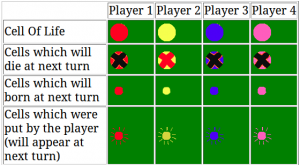 Brettspiel ”Buntes Leben”
Brettspiel ”Buntes Leben”
(Spielanleitung)
-Spieleranzahl:
Das Spiel ist für 2 Spieler gedacht/konzipiert.
-Spielutensilien/ Spielmaterialien:
1) Kariertes Feld 8×8 (z.B. ein Schachspielbrett)
2) 2 Typen von Spieljetons/Tokens/Damen:
Hauptjetons: grosse, platte Jetons (ca. 20-30 Stück) in 2 verschiedenen Farben.
Jeder Spieler bekommt/ hat eigene Jetons/ eigene Farbe. Als Hauptjetons können z.B. Jetons fürs Pokerspiel, Damenspiel (2 Exemplarspiele) usw. dienen.
Hilfejetons: bunt oder schwarz/weiss, z.B. etwas kleinere Jetons, egal welcher Form, in 2 verschiedenen Farben. Die Farben von Hilfejetons können den Farben von Hauptjetons entsprechen, müssen aber nicht unbedingt.
Die Anzahl von Hilfejetons ist etwas kleiner als die Anzahl von Hauptjetons. Es wird ca. 10-20 Stück für ein Spiel benötigt. Es können auch weitere kleine Hilfejetons eingeführt bzw. benutzt werden, z.B. Mini-Damen, Schachfiguren (kleine Bauer) etc.
3) Irgendwas, was dabei behilflich sein kann, einen Spieler zufällig auszusuchen, z.B. ein Spielwürfel, eine Münze. Es kann auch ”Schnick, Schnack, Schnuck”/ ”Schere-Stein-Papier” gespielt werden oder etwas anderes.
-Ausgangsposition:
Der erste Spieler kann seine 5 Hauptjetons/ Tokens auf verschiedene Zellen in der linken oberen Ecke des Spielbrettes platzieren (eigenes Spielterritorium am Anfang: 4×4 in der linken oberen Ecke).
Der zweite Spieler kann seine 5 Hauptjetons/ Tokens in der rechten unteren Ecke des Spielbrettes (eigenes Territorium am Start entspricht ¼ des gesamten Spielbrettfeldes: 4×4 in der rechten unteren Ecke) platzieren.
-Spielbeschreibung/ Spielgang:
Die Spielsituation entwickelt sich schrittweise in Spielgängen. Bei jedem Spielgang gibt es verschiedene Spielhandlungen/ Operationen:
1. Platzierung der Hilfejetons:
Auf dem Spielbrett werden während des Spiels die Hilfejetons platziert. Dabei sind folgende Spielregeln zu beachten:
——> Wenn sich in der Nähe (horizontal, vertikal und diagonal) von Hauptjeton(s) weniger als 2 oder mehr als 3 Hauptjetons (egal welcher Farbe) befinden, wird diese Zelle/ dieser Jeton/Token als ”sterbend” markiert. Dafür wird oben auf diese/n Hauptjeton(s) eine kleine (schwarze) Dame gelegt. Wichtig: Die sterbenden Zellen/ Jetons werden NICHT beim Ausrechnen von Jetons in/von den Nachbarschaftszellen ausgeschlossen und BEEINFLUSSEN auch die Ausrechnung von den Nachbarschaftszellen/Jetons/Tolkens.
——> Wenn sich in der Nähe einer leeren Zelle genau 3 Hauptjetons egal welcher Farbe und in welcher Lebensphase (sterbend oder lebendig) befinden, wird diese Zelle auf dem Brettspiel als ”neugeboren” visuell markiert. Auf diese ”neugeborene” Zelle wird eine (weisse) kleine Dame, die als Hilfejeton gilt, aufgesetzt. Die Farbe der neugeborenen Zelle wird durch die Farbe der benachbarten Hauptjetons, die überwiegen oder am meisten vorhanden sind, (vor)bestimmt. Die neugeborenen Zellen/Jetons beeinflussen die Platzierung der Hilfejetons NICHT und werden NICHT beim Ausrechnen der benachbarten Zellen/ Nachbarschaftszellen beachtet.
2. Austausch der Hilfejetons durch Hauptjetons:
Alle Hilfejetons/kleinere Damen werden auf dem Spielbrett durch Hauptjetons ausgetauscht. Dabei sind folgende Regeln zu beachten:
– sterbende Zellen/Hauptjetons/ Tokens, auf denen sich ein Hilfejeton befindet, werden komplett vor dem Brettspiel/ Spielfeld weggeräumt/ entfernt.
– neugeborene Zellen/Hilfejetons/Damen in/auf den leeren Zellen werden durch die Hauptjetons (überwiegender Farbe) ausgetauscht.
-Einfluss der Spieler auf den Spielvorgang:
Je 2 Spielgänge/Spielrunden, vor der eigentlichen Platzierung von Hilfejetons, haben die Spieler eine Möglichkeit noch einen zusätzlichen Hauptjeton ihrer Farbe auf dem Spielbrett zu platzieren. Wichtig: Wer als erste/r einen zusätzlichen Hauptjeton platzieren darf, kann per Zufall, z.B. durch einen Spielwürfel, Münzenwurf oder durch ein ”Schnick, Schnack, Schnuck”- Spiel bestimmt werden.
Der neue Hauptjeton kann nur in der Nähe von den eigenen Hauptjetons, die schon bereits existieren, platziert werden.
–Gewinnbedingungen:
-Der Spieler verliert, wenn auf dem Spielbrett keine von seinen Jetons vorhanden sind.
-Wenn ein Spieler verloren hat aber der zweite im Gegenteil noch die Jetons auf dem Brettspiel hat bzw. besitzt, dann gilt dieser zweite als Gewinner.
-Spieldynamik/Veränderbarkeit der Spielregeln:
Das Spiel bietet auch unerwartete und spannende Momente an, indem es während des Spiels zu verschiedenen Jetonskonstellationen/ Symbiosen kommen kann.
Die Regeln sind veränderbar, z.B. können es bis zu 5 zusätzlichen Hauptjetons nach der Absprache der Spieler auf einmal platziert werden. Diese Entscheidung müssen die Spieler vor dem Spiel treffen. Bei den richtigen/ gut überlegten Spielgängen kann das Spiel länger gespielt werden oder auch schneller beendet werden. Dies ist den Spielern selbst überlassen.
*Kommentare, Anregungen, Korrekturen und Überarbeitungen sind gerne willkommen. 😛
Viel Spass beim Spielen!!! 🙂
Spielanleitung zum Downloaden (Pdf-Datei)






